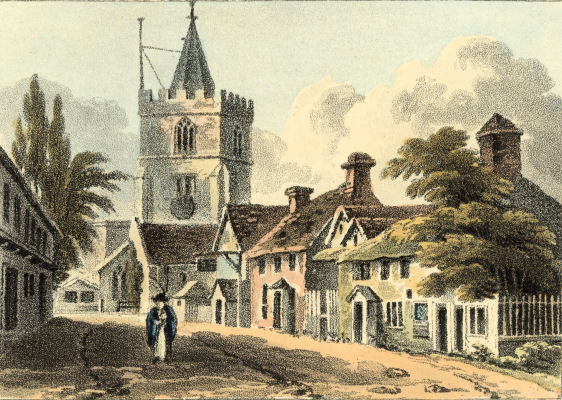|
|
Rickmansworth in 1807 |
|
|
|
Rickmansworth in 1807 |
|

Picture from Picturesque Rides and Walks, 1817-8
The following account come from The Beauties of England and Wales; or Original Deliniations, topographical, historical, and descriptive, of each county, embellished with engravings, Volume IX, by John Britton, London 1807
Rickmansworth or Rickmersworth, as it is sometimes called, and with great propriety, is a small market town, occupying a low moorish situation near the confluence of the rivers Gade and Colne, and a small rivulet, which flows from Chesham and Flaunden, in Buckinghamshire. The manor was an ancient demesne of the Saxon Kings, and was given by King Offa, to the Abbey at St. Alban's, to which it was confirmed by succeeding Kings, and had a charter of a weekly market, and two annual fairs, granted by Henry the Third. After the Dissolution, Edward the Sixth gave the manor to Ridley, Bishop of London: but Queen Mary bestowed it on the fell persecutor Bishop Bonner. In Elizabeth's time it reverted to the crown; and was finally sold by Charles the First, and the Six Clerks in Chancery, to whom he had conveyed it as a security for borrowed money, to Sir Thomas Fotherley, whose son, John, was Sherriff of Herts in the fourth of Charles the Second. The family became extinct by the dreadful event of its possessor, son of the last-mentioned gentleman, being swallowed up, with his only daughter, in the great earthquake at Jamaica, in 1694. He bequeathed the reversion of the manor to his nephew, Temple Whitfield, Esq., whose descendant, Herny Fotherly Whitfield, Esq. is now owner; and whose Mansion, called the Bury, an irregular brick edifice, nearly adjoins the Church-yard on the west side.
The Church is a spacious building, dedicated to the Virgin Mary, and consisting of a nave, aisles, and chancel, with a handsome embattled tower of hewn flints at the west end: the upper part of the nave is also embattled; and the butresses are very strong. On each side the nave are five plain pointed arches, rising from round columns, with square windows above, each divided into two trefoil-headed lights. Beyond these, extending across the space that appears to have originally been the chancel, is a large pointed arch; and at the sides, eastwards, two other arches, springing from octagonal columns, and reaching to the entrance of the present chancel. The edifice was repaired in the year 1677, and again in the years 1802, and 1803: the large gallery which is at the west end, was probably erected about the former period.
The situation of Rickmersworth in the vicinity of several streams, renders it very convenient in trades that require the aid of water; and several mills, for various purposes, have been erected in its neighbourhood. At the entrance of the town from the south, is a large cotton and flour-mill; a flock mill, and a silk mill, have recently been built at a little distance to the west; and towards the north, on the rivulet that flows from Chesham, are several paper-mills, &c. The manufacture of straw-plait furnishes additional employment, particularly to girls and women. The Market-House is a mean wooden fabric, supported on pillars, and open beneath. The Market was formerly celebrated for its corn trade, but is now little frequented, though toll free. The population of Rickmersworth, as ascertained under the Act of 1800, amounted to 2975, the number of houses to 503.
[The account also contains a description of some memorials in the Church and the nearby manor of Moor - later Moor Park, in Middlesex.]
John Britton, The Beauties of England and Wales, London 1807
| January 2011 | Page created | |